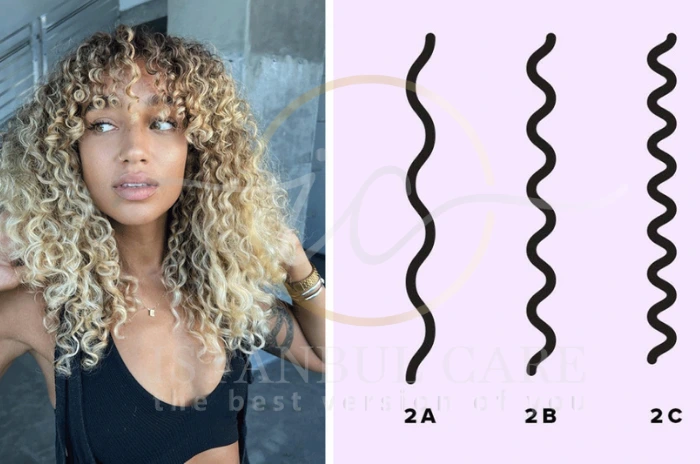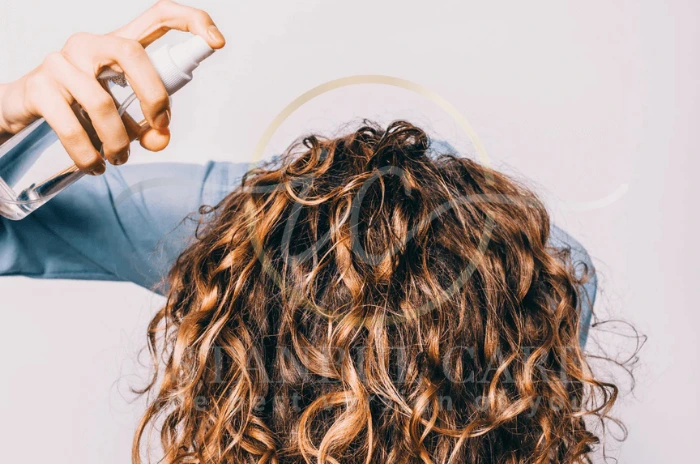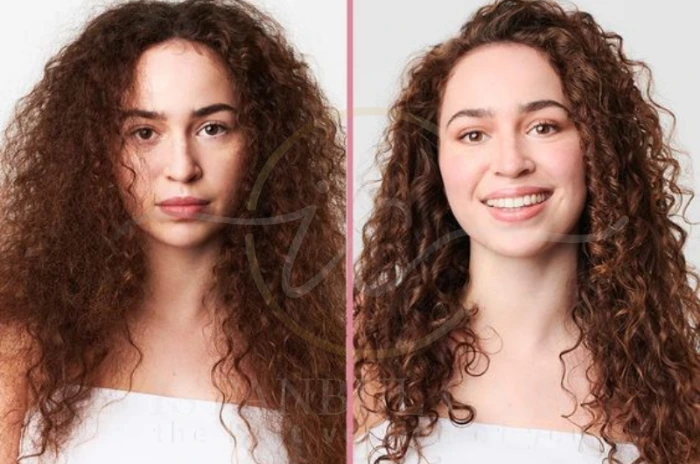Type 2C hair represents one of the most dynamic and beautiful wavy hair textures, sitting perfectly between loose waves and tight curls. If you’ve been struggling to understand your wavy hair care routine or wondering why your waves behave differently from others, you might have 2C wavy hair characteristics that require specific attention and care.
This comprehensive guide will help you identify, understand, and properly care for type 2C hair, providing you with expert styling tips, product recommendations, and effective methods for frizz control for 2C hair. Whether you’re new to the wavy hair journey or looking to refine your current routine, this guide covers everything you need to know about managing and embracing your gorgeous 2C waves.

What Is Type 2C Hair?
Type 2C hair is the most pronounced wavy texture, featuring well-defined S-shaped waves that start from roots to ends. This hair type has more body and volume than 2A and 2B waves, with coarser, thicker individual strands.
The wave pattern remains consistent throughout, creating naturally voluminous hair that holds styles well but requires proper frizz control for wavy hair.
Key Characteristics of Type 2C Wavy Hair
2C wavy hair characteristics include:
- Well-formed, resilient S-shaped waves
- Medium to thick density with substantial strands
- Coarser texture compared to finer wave patterns
- Natural lift at roots with good style retention
- Prone to frizz in humid conditions
How Type 2C Differs from Other Wavy Hair Types
2C vs 3A hair: While 2C maintains S-shaped waves, 3A forms loose spirals. Type 2C hair lies flatter against the head with more structured waves than looser 2A and 2B textures.
| Hair Type | Wave Pattern | Texture | Volume | Product Needs |
|---|---|---|---|---|
| 2A Hair | Loose waves | Fine | Low | Lightweight |
| 2B Hair | Medium waves | Medium | Moderate | Balanced |
| 2C Hair | Tight waves | Coarse | High | Light-Medium |
Best Care Routine for Type 2C Hair
Developing an effective 2C hair care routine requires understanding the unique needs of this texture. The key is balancing moisture, definition, and volume while preventing frizz and maintaining the natural wave pattern. Consistency in your routine will yield the best results for your wavy hair maintenance.
A successful routine focuses on gentle cleansing, adequate moisture, and lightweight styling products that enhance rather than compete with your natural texture. How to care for 2C hair involves working with your waves rather than against them, using techniques that support and define your natural pattern.
Cleansing and Conditioning for Defined Waves
Sulfate-free shampoo 2C hair care begins with choosing the right cleansing products. Sulfates can strip natural oils and disrupt the wave pattern, leading to frizz and dryness. Look for gentle, hydrating shampoos that cleanse without over-drying your hair.
Conditioning is equally important for type 2C hair. Focus on mid-lengths to ends, avoiding the roots to prevent weighing down your waves. Deep conditioning treatments should be incorporated weekly to maintain hydration for 2C hair and keep the texture healthy and manageable.
Lightweight Products to Enhance 2C Waves
Lightweight products for wavy hair are essential for type 2C hair success. Heavy creams and oils can weigh down your waves, causing them to lose their bounce and definition. Instead, opt for mousses, light gels, or cream-gel hybrids that provide hold without heaviness.
Defining 2C waves requires products that enhance your natural texture while controlling frizz. Look for formulations specifically designed for wavy hair that contain ingredients like lightweight oils, proteins for structure, and humectants for moisture balance.
How to Reduce Frizz in Type 2C Hair
Manage frizz 2C hair by focusing on moisture and protection. Frizz often occurs when hair lacks adequate hydration or is damaged by environmental factors. Use leave-in conditioners and anti-humidity products to create a protective barrier around each strand.
Gentle handling is crucial for frizz prevention. Avoid towel-drying with regular terry cloth towels, instead using microfiber towels or cotton t-shirts. When detangling, always work on wet hair with a wide-tooth comb or your fingers, starting from the ends and working upward.
Meet the Type 2 Subtypes – 2A, 2B, 2C
Understanding the broader category of hair type 2 helps contextualize where 2C hair fits in the wavy spectrum. Each subtype has distinct characteristics and care requirements, making it important to accurately identify your specific texture for optimal results.
2A vs 2B vs 2C hair differences become apparent when examining wave definition, volume, and texture coarseness. This classification system helps determine the most appropriate products and techniques for your specific wavy hair needs.
2A Hair: Fine Waves, Low Density
2A hair represents the finest and most delicate wavy texture. The waves are subtle and loose, often barely noticeable when hair is wet. This texture tends to have lower 2c hair density compared to other wavy types and can easily be weighed down by heavy products.
2A hair often struggles with maintaining wave definition throughout the day and may appear almost straight in some lighting. It requires the lightest products and gentlest techniques to avoid disrupting the delicate wave pattern.
2B Hair: Defined Waves, Medium Texture
2B hair falls in the middle of the wavy spectrum, with more defined S-shaped waves than 2A but less pronounced than 2C. The texture is medium weight, with moderate volume and bounce. This hair type typically responds well to a variety of styling products and techniques.
2B waves are more resilient than 2A but not as structured as 2C. They can handle slightly more product weight while still maintaining their natural movement and bounce throughout the day.
2C Hair: Tight Waves, High Volume
2C hair represents the most defined end of the wavy spectrum. The waves are tight, well-formed, and create significant natural volume. This texture often has the highest density among wavy hair types and can sometimes approach the characteristics of loose curls.
The coarser texture and strong wave pattern make type 2C hair more resilient to environmental factors while also being more responsive to styling products and techniques. This hair type often serves as a bridge between wavy and curly textures.

Styling Tips for Type 2C Hair
Effective styling tips for 2C waves focus on enhancing your natural texture while providing adequate hold and frizz control. The goal is to work with your waves rather than forcing them into unnatural patterns, creating styles that last throughout the day.
Defining waves 2C hair requires understanding how your specific hair responds to different techniques and products. Experimentation and patience are key to finding the perfect styling routine that brings out the best in your waves.
Techniques to Boost Wave Definition
Defining 2C waves starts with proper application techniques. Scrunching products into damp hair helps encourage wave formation while distributing product evenly. The “praying hands” method can also help smooth products along the hair shaft without disturbing the wave pattern.
Plopping is another effective technique for type 2C hair. This method involves wrapping wet, product-laden hair in a cotton t-shirt or microfiber towel to encourage wave formation while removing excess moisture. Leave hair plopped for 10-20 minutes before air-drying or diffusing.
Avoiding Heavy Products That Weigh Down Waves
Heavy products are the enemy of type 2C hair volume and definition. Avoid thick creams, heavy oils, and products with waxes or petrolatum that can coat the hair shaft and prevent natural movement. Instead, focus on lightweight products for wavy hair that provide hold without heaviness.
Layer products strategically, starting with the lightest formulations closest to the hair and building up density as needed. This approach prevents product overload while ensuring adequate coverage and hold for your waves.
Air-Drying vs. Diffusing for Type 2C Hair
Both air dry 2C hair and diffusing 2c hair methods have their benefits. Air-drying creates the most natural texture and reduces heat damage, but it takes longer and may result in less volume. Diffusing can enhance volume and speed up the drying process while maintaining wave definition.
When diffusing, use low heat and low speed settings to prevent frizz. Hover the diffuser around sections of hair without touching, allowing the waves to dry gently. If air-drying, avoid touching or manipulating hair until it’s completely dry to prevent frizz and wave disruption.
How to Build a Type 2C Hair Routine
Building an effective 2C hair care routine requires consistency and understanding of your hair’s specific needs. The routine should address cleansing, conditioning, styling, and maintenance while being sustainable for your lifestyle and budget.
Best products for 2C hair form the foundation of your routine, but technique and timing are equally important. Establishing a routine that you can follow consistently will yield better results than sporadic use of premium products.
Gentle Cleansing with Sulfate-Free Shampoo
Sulfate-free shampoo 2C hair care begins with choosing cleansing products that respect your hair’s natural oils and wave pattern. Sulfates can be overly harsh, stripping essential moisture and causing frizz and dryness in wavy hair.
Look for shampoos with gentle surfactants like cocamidopropyl betaine or sodium cocoyl isethionate. These ingredients cleanse effectively without over-stripping, maintaining the moisture balance that type 2C hair needs for optimal wave formation and health.
Importance of Deep Conditioning Treatments
Hydration for 2C hair is crucial for maintaining healthy, defined waves. Deep conditioning treatments should be incorporated into your routine weekly or bi-weekly, depending on your hair’s condition and porosity level.
A hair porosity test can help determine how often your hair needs deep conditioning. Low porosity hair may need treatments less frequently, while high porosity hair benefits from more regular intensive moisture treatments to maintain health and definition.
Choosing the Right Leave-In Products
Leave-in products are essential for type 2C hair success. They provide ongoing moisture, frizz control, and light hold throughout the day. Choose leave-ins that complement your styling products without causing buildup or weighing down your waves.
The best leave-in products for 2C hair contain hydrating ingredients like aloe vera, glycerin, and lightweight oils. Avoid products with heavy silicones or waxes that can accumulate and dull your wave pattern over time.
Recommended Products for 2C Hair
Selecting the best products for type 2C hair requires understanding ingredient lists and how different formulations interact with wavy hair. The right product combination can transform your waves from frizzy and undefined to smooth and bouncy.
Carol’s Daughter 2C hair products and similar brands designed specifically for textured hair often provide excellent options for wavy hair care. Look for products that specifically mention wavy hair or texture enhancement on their packaging.
Curl Creams and Leave-In Conditioners
Curl creams designed for wavy hair provide moisture and light hold without the heaviness of traditional styling creams. These products should enhance your natural texture while providing frizz control and definition.
Leave-in conditioners for type 2C hair should be lightweight yet moisturizing. They create a protective barrier against humidity while maintaining hair flexibility and movement. Apply these products to damp hair for best results.
Lightweight Gels and Mousses
Gels and mousses specifically formulated for wavy hair provide hold and definition without stiffness or crunchiness. Look for products that dry flexible and can be scrunched out once dry for natural-looking, touchable waves.
The best styling products for 2C hair contain film-forming ingredients that create a flexible cast around waves, protecting them from humidity and environmental damage while maintaining natural movement and bounce.
Ingredients to Look for (and Avoid)
Beneficial ingredients for type 2C hair include lightweight oils like argan or jojoba, proteins for structure, and humectants like glycerin for moisture. Natural extracts and botanicals can also provide additional benefits without heaviness.
Avoid ingredients that can weigh down waves or cause buildup. These include heavy silicones, mineral oil, petrolatum, and sulfates. Reading ingredient lists becomes easier with practice and helps ensure you’re choosing products that support your hair goals.
Extra Tips for Long-Term 2C Hair Health
Maintaining healthy type 2C hair requires attention to both daily care and long-term health strategies. Protecting your waves from damage while supporting their natural pattern ensures continued beauty and manageability.
Wavy hair maintenance tips extend beyond daily styling to include protective practices, regular trims, and damage prevention strategies that keep your hair looking its best over time.
Protecting Hair Overnight
Overnight protection is crucial for maintaining 2C waves and preventing morning frizz. Silk or satin pillowcases reduce friction and help preserve your wave pattern while you sleep.
The “medusa clipping” method involves loosely clipping sections of hair on top of your head to prevent crushing waves against the pillow. Alternatively, a silk or satin bonnet can protect your entire head while you sleep.
Avoiding Heat and Chemical Damage
Heat and chemical damage can permanently alter your wave pattern and overall hair health. Minimize use of flat irons, curling irons, and blow dryers without diffuser attachments. When heat styling is necessary, always use a heat protectant product.
Chemical treatments like relaxers, perms, or frequent coloring can damage the hair cuticle and disrupt natural wave patterns. If you choose to color your hair, consider gentler options like semi-permanent dyes or professional treatments that minimize damage.
Trimming and Detangling Without Breakage
Regular trims every 6-8 weeks help maintain healthy ends and prevent split ends from traveling up the hair shaft. Ask your stylist to cut your hair when dry so they can see your natural wave pattern and create a shape that enhances your texture.
Detangling should always be done on wet hair with adequate slip from conditioner or detangling products. Start from the ends and work your way up, never forcing through tangles that could cause breakage or damage to your wave pattern.

Common 2C Hair Challenges & Solutions
Type 2C hair comes with specific challenges that require targeted solutions. Understanding these common issues and their remedies helps you troubleshoot problems and maintain healthy, beautiful waves.
Addressing challenges proactively rather than reactively leads to better long-term results and helps you develop a deeper understanding of your hair’s unique needs and responses.
How to Reduce Frizz in 2C Hair
Frizz control for 2C hair starts with proper moisture balance and protection from environmental factors. Frizz often occurs when the hair cuticle is raised, allowing moisture to enter and exit unpredictably.
Use products with anti-humidity ingredients like silicones or natural waxes that create a protective barrier. Regular deep conditioning treatments also help smooth the cuticle and reduce frizz susceptibility.
Preventing 2C Waves from Falling Flat
Flat waves can result from product overload, root weight, or lack of proper support during drying. Avoid applying styling products too close to the roots, and ensure you’re using appropriate amounts for your hair length and density.
Root clipping while air-drying or diffusing can help maintain volume at the crown. Lifting sections of hair and clipping them up allows air circulation and prevents the weight of wet hair from pulling waves flat.
Avoiding Product Buildup on Wavy Hair
Product buildup can weigh down type 2C hair and dull the wave pattern. Regular clarifying washes help remove accumulated products, hard water minerals, and environmental pollutants that can coat the hair shaft.
Use clarifying shampoo once every 2-4 weeks, depending on your product usage and water quality. Follow with a deep conditioning treatment to restore moisture after the more intensive cleansing.
Fighting Frizz in 2C Hair
Frizz control for wavy hair requires a multi-faceted approach that addresses the root causes of frizz while providing ongoing protection and management strategies.
Understanding why frizz occurs in type 2C hair helps you choose the most effective prevention and treatment methods for your specific situation and environment.
Best Anti-Frizz Products for Wavy Hair
Anti-frizz products for 2C hair should provide moisture, protection, and light hold without weighing down your waves. Look for products containing ingredients like hydrolyzed proteins, natural oils, and film-forming polymers.
Serums and leave-in treatments specifically designed for frizz control can be applied to damp or dry hair for ongoing protection. These products work best when applied to hair that’s already been properly cleansed and conditioned.
Humidity-Proofing Your 2C Waves
Humidity can be particularly challenging for type 2C hair, causing frizz and disrupting wave patterns. Products with anti-humidity technology create a barrier that prevents excess moisture from entering the hair shaft.
Layering products strategically can also help with humidity protection. Start with a leave-in conditioner for moisture, follow with a light gel or cream for hold, and finish with an anti-humidity serum for protection.
Solving Common 2C Hair Issues
Type 2C hair presents unique challenges that require specific solutions. Understanding these issues and their remedies helps you maintain healthy, beautiful waves regardless of environmental conditions or styling challenges.
Problem-solving approaches for wavy hair often require patience and experimentation to find the right combination of products and techniques for your specific hair needs.
Combatting Frizz in Humid Climates
Humid climates pose particular challenges for manage frizz 2C hair goals. The excess moisture in the air can disrupt the hair cuticle and cause waves to become undefined and frizzy.
Anti-humidity products become essential in these environments. Look for ingredients like dimethicone or amodimethicone that create a protective barrier around each hair strand, preventing excess moisture absorption while maintaining flexibility.
Preventing Wave Pattern Collapse
Wave pattern collapse occurs when 2C waves lose their definition and bounce, often due to product overload, improper drying techniques, or environmental factors. Prevention focuses on proper product selection and application techniques.
Avoid heavy products at the roots and ensure proper distribution of styling products throughout your hair. Drying techniques that support wave formation, such as plopping or diffusing, help maintain pattern integrity throughout the day.
Managing Dryness in Wavy Hair
Dryness in type 2C hair can lead to frizz, breakage, and loss of wave definition. Hydration for 2C hair requires both internal moisture from conditioners and external protection from leave-in products.
Regular deep conditioning treatments help restore moisture to the hair shaft, while daily leave-in products provide ongoing hydration and protection. Pay attention to your hair’s changing needs with seasons and environmental conditions.
Comparing Type 2 Hair with Other Hair Types
Understanding hair type comparison helps contextualize where type 2C hair fits within the broader spectrum of hair textures. These comparisons help you better understand your hair’s unique characteristics and needs.
Type 2 hair represents the wavy category, distinct from straight (Type 1) and curly (Type 3) hair patterns. Each type has specific care requirements and responds differently to products and techniques.
Type 2 vs Type 1: Wavy vs. Straight Hair
Type 1 hair is naturally straight with no wave or curl pattern, while Type 2 hair has varying degrees of wave formation. The care needs differ significantly, with wavy hair requiring products that enhance and define natural texture.
Straight hair often needs volume-building products and techniques, while type 2C hair naturally has volume and needs products that control frizz and enhance wave definition without weighing down the hair.
Type 2 vs Type 3: Wavy vs. Curly Hair Patterns
Type 3 hair forms distinct spirals and curls, while Type 2 hair maintains an S-shaped wave pattern. The transition between 2C vs 3A hair can sometimes be subtle, but the curl formation is the key distinguishing factor.
Type 3 hair generally requires heavier products and more intensive moisture treatments, while type 2C hair needs lighter formulations that enhance waves without creating weight or buildup that could disrupt the pattern.
Speak with our expert Hair Transplantation specialists

Speak with our expert Hair Transplantation specialists
We’re ready to answer your questions
FAQs for What Is 2C Hair? The Complete Guide to Wavy Hair
Type 2C hair is the most defined wavy texture with tight, well-formed S-shaped waves that create natural volume and body, differing from looser 2A and 2B waves through its coarser texture and stronger wave pattern.
2C wavy hair characteristics include well-defined waves, medium to thick density, coarser texture, and natural volume, with main challenges being frizz control, preventing wave collapse, and finding the right balance of moisture and lightweight products.
An effective 2C hair care routine includes sulfate-free shampooing 2-3 times weekly, regular conditioning, weekly deep treatments, and daily styling with lightweight products followed by air-drying or gentle diffusing.
Best products for type 2C hair include sulfate-free shampoos, lightweight conditioners, curl creams, mousses, flexible-hold gels, and leave-in treatments that provide moisture and frizz control without weighing down waves.
Frizz control for 2C hair involves using sulfate-free products, regular deep conditioning, anti-humidity styling products, gentle drying methods, and avoiding touching or manipulating hair until completely dry.
Styling tips for 2C waves include scrunching products into damp hair, using the praying hands method, plopping with cotton t-shirts, root clipping for volume, and choosing between air-drying or low-heat diffusing.
2C vs 3A hair differs in that 2C maintains S-shaped waves while 3A forms loose spirals; 2C typically requires lighter products and different styling techniques compared to the heavier formulations needed for curly hair.
Long-term wavy hair maintenance tips include regular trims every 6-8 weeks, overnight protection with silk materials, minimizing heat and chemical damage, gentle detangling on wet hair, and consistent use of appropriate products for your texture.

